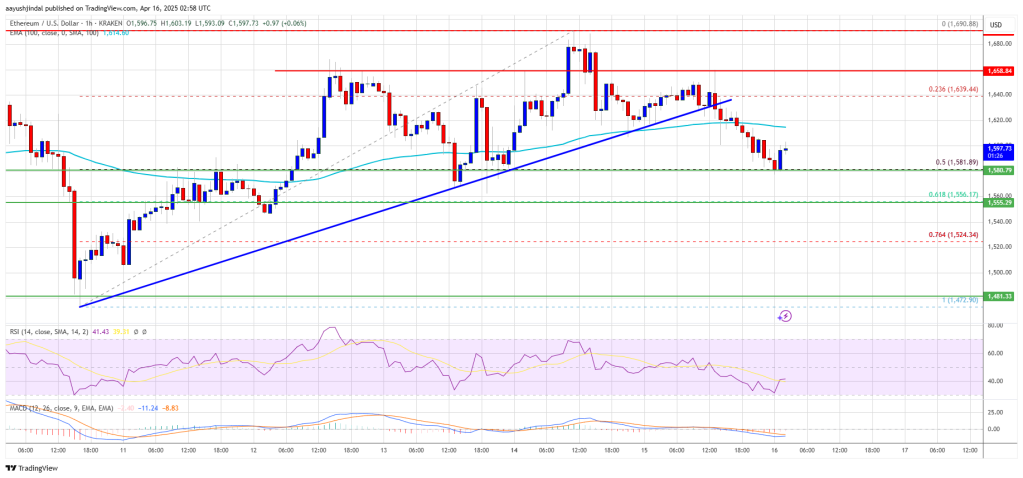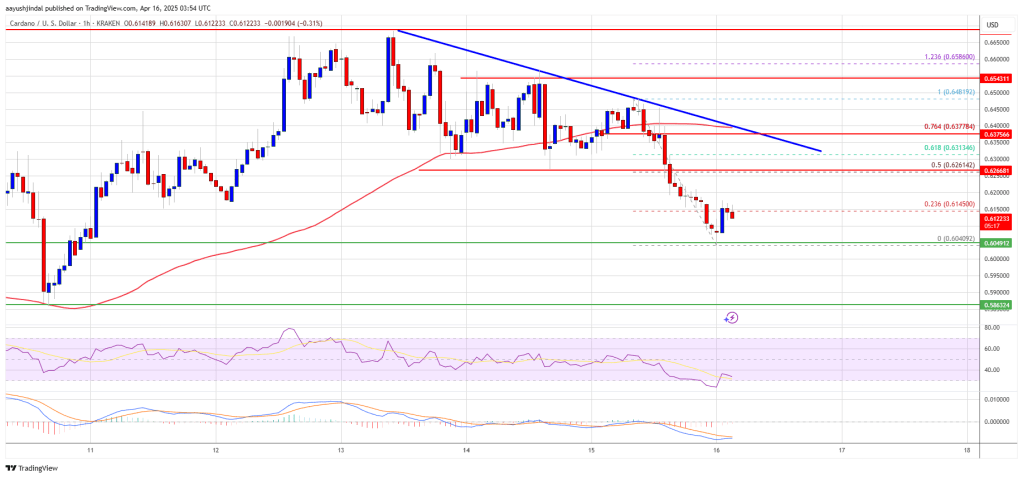Market
Web3 Projects Adjust to Market Chaos


Crypto and global markets are reeling from the escalating trade war sparked by President Trump’s latest tariffs. Bitcoin, Ethereum, and Solana have plummeted this week, sending Web3 projects into a tailspin.
BeInCrypto contacted Shane Molidor, founder of Forgd, which has shepherded over 1,000 token launches. The former Gemini business development associate explains how fledgling ventures that once relied on a 2025 bull market adjust strategies and survival tactics.
Market Turmoil Forces Web3 Projects to Rethink Token Launches
Molidor unpacked how Web3 teams are rethinking everything from airdrops to tokenomics. Citing retail exhaustion that has collided with this week’s crypto market panic, he says demand for new tokens is dimming.
“Launching in these conditions risks a flop, and that’s a death knell for projects needing momentum,” he started.
Most projects try to time their token generation events (TGEs) with a bull market to ride speculative retail demand. When the macro market tanks, like it has this week, they hesitate to list.
Poor price performance scares off future investors. Token launches, which once drew excitement, are now becoming high-risk gambles. The market conditions are forcing many to delay or reconsider their approaches.
“The pressure is building, and with major cryptocurrencies like Bitcoin and Ethereum taking a hit, teams are wary of entering the market with new tokens,” Molidor adds.
Airdrops Under Fire: From Hype Machine to Risky Proposition
Crypto airdrops, once a go-to for user acquisition and buzz, are also under fire. Molidor notes that founders have become more cautious.
“Big airdrops often trigger sell pressure that kills TGE buzz,” he says.
Exceptions like Solana-based Jito (JTO) airdrop aligned well with market timing and community engagement, passing as outlier successes. Amidst prevailing bearish sentiment, however, the trend is shifting toward more targeted reward mechanisms that focus on filtering out speculative traders.
“Founders are moving toward methods like vesting periods, Sybil resistance, and eligibility filters to route tokens to crypto-native users rather than to people just looking to cash out immediately,” Molidor adds.
This suggests utility is crucial now, with the Forgd executive articulating that airdrops without a clear narrative and use case will fall flat.
Tokenomics: The Return of Low Float, High FDV Models
Tokenomics is also undergoing a makeover. Molidor notes that low float, high fully diluted valuation (FDV) strategies are back in fashion as projects attempt to curb sell-offs from airdrop dumpers. These models limit the circulating supply at launch, giving the impression of high value.
“It’s an illusion of strength. Early price pops distort market caps, but thin liquidity and front-loaded unlocks alienate both retail and institutional investors,” Molidor cautions.
This approach can appear predatory, enticing retail investors only to leave them with little liquidity and big insider exits.
However, Molidor notes that the market is wise to these games now. Projects must ensure that tokenomics are well-designed to foster long-term growth and avoid manipulation. Instead of chasing short-term hype, Molidor urges founders to focus on strategies that promote real user adoption.
“The key is balance. You want tokenomics that encourage long-term engagement while still protecting against early sell pressure,” he explained.
The Funding Drought: Crowd Funding and Angel Investors Step In
Molidor also demonstrated cognizance that the venture capital playing field has shifted dramatically. With funding tightening over the last 12 months, many Web3 projects are turning to alternative sources of capital.
Crowdfunding platforms like Legion and Echo are gaining traction among perceptive retail investors. They offer smaller, more flexible funding rounds. However, these rounds often cannot replace the scale of traditional venture capital.
“Crowdfunding is definitely on the rise, especially for earlier-stage projects. However, while crowd-funding platforms are becoming a vital tool, they are not a one-stop shop. Projects will still need larger rounds of VC funding to scale and deliver on their long-term visions,” he noted.
In response, venture capitalists are doubling down on early-stage equity and token stakes to offset dilution from later crowdfunding efforts.
According to Molidor, this strategy is creating an interesting dynamic in the funding arena, with VCs pushing for larger ownership stakes earlier in the process.
Compared to previous bear markets, he says this adjustment is a return to fundamentals but with more sophistication. In past bear markets, projects would typically delay their launches or aggressively cut costs. However, Molidor says that founders are taking a more nuanced approach.
“Delays and cost-cutting are still part of the playbook, but what’s different now is the level of sophistication in how teams manage their tokenomics, airdrops, and launch strategies. The cost of a mispriced launch is brutal reputationally and economically. Retail is fatigued, VCs are more hands-on, and communities are quicker to call out misaligned interests,” he explained.
Based on these, Molidor and his team at Forgd advise projects to take a surgical approach. The most successful projects take the time to understand their community, create value, and resist the urge to chase short-term hype.
“Narrative-driven airdrops, intentional community sales, and valuations built to last,” he advises.
A Market Test of Web3’s Resilience
Molidor says that the next six months will test Web3’s resilience. The sharpest projects will weather the storm as Trump’s tariffs upend the early-2025 bull market dreams.
“Token design is like capital structure now. It’s deliberate, contextual, and enduring—that’s what wins,” Molidor concludes.
For founders, it is adapt or die. For investors and users, it is a front-row seat to crypto’s latest crucible. Only the most thoughtful and strategic projects will succeed in this challenging market environment.
Disclaimer
In adherence to the Trust Project guidelines, BeInCrypto is committed to unbiased, transparent reporting. This news article aims to provide accurate, timely information. However, readers are advised to verify facts independently and consult with a professional before making any decisions based on this content. Please note that our Terms and Conditions, Privacy Policy, and Disclaimers have been updated.
Market
Ethereum Price Dips Again—Time to Panic or Opportunity to Buy?

Reason to trust

Strict editorial policy that focuses on accuracy, relevance, and impartiality
Created by industry experts and meticulously reviewed
The highest standards in reporting and publishing
Strict editorial policy that focuses on accuracy, relevance, and impartiality
Morbi pretium leo et nisl aliquam mollis. Quisque arcu lorem, ultricies quis pellentesque nec, ullamcorper eu odio.
Ethereum price started a fresh decline from the $1,690 zone. ETH is now consolidating and might decline further below the $1,580 support zone.
- Ethereum started a fresh decline after it failed to clear $1,700 and $1,720.
- The price is trading below $1,620 and the 100-hourly Simple Moving Average.
- There was a break below a new connecting bullish trend line with support at $1,625 on the hourly chart of ETH/USD (data feed via Kraken).
- The pair could start a fresh increase if it clears the $1,640 resistance zone.
Ethereum Price Faces Rejection
Ethereum price formed a base above $1,550 and started a fresh increase, like Bitcoin. ETH gained pace for a move above the $1,600 and $1,620 resistance levels.
The bulls even pumped the price above the $1,650 zone. A high was formed at $1,690 and the price recently corrected gains. There was a move below the $1,640 support zone. Besides, there was a break below a new connecting bullish trend line with support at $1,625 on the hourly chart of ETH/USD.
The price tested the 50% Fib retracement level of the upward move from the $1,472 swing low to the $1,690 high. Ethereum price is now trading below $1,625 and the 100-hourly Simple Moving Average.
On the upside, the price seems to be facing hurdles near the $1,620 level. The next key resistance is near the $1,640 level. The first major resistance is near the $1,650 level. A clear move above the $1,650 resistance might send the price toward the $1,690 resistance.

An upside break above the $1,690 resistance might call for more gains in the coming sessions. In the stated case, Ether could rise toward the $1,750 resistance zone or even $1,800 in the near term.
More Losses In ETH?
If Ethereum fails to clear the $1,640 resistance, it could start another decline. Initial support on the downside is near the $1,580 level. The first major support sits near the $1,555 zone and the 61.8% Fib retracement level of the upward move from the $1,472 swing low to the $1,690 high.
A clear move below the $1,555 support might push the price toward the $1,525 support. Any more losses might send the price toward the $1,450 support level in the near term. The next key support sits at $1,420.
Technical Indicators
Hourly MACD – The MACD for ETH/USD is gaining momentum in the bearish zone.
Hourly RSI – The RSI for ETH/USD is now below the 50 zone.
Major Support Level – $1,580
Major Resistance Level – $1,640
Market
Semler Doubles Down on Bitcoin Investments Despite Losses

Semler Scientific (SMLR), a US-based medical technology company, has revealed plans to acquire more Bitcoin (BTC) despite facing a 5.0% unrealized loss on its previous BTC investments.
The firm has filed a Form S-3 registration with the US Securities and Exchange Commission (SEC) to raise up to $500 million through a securities offering. The proceeds would be allocated for general corporate purposes, including expanding its Bitcoin portfolio.
Semler Scientific Files S-3 to Fund Bitcoin Investments
According to the official filing, the firm plans to issue common stock, preferred stock, debt securities, and warrants as part of the securities offering. The SEC filing does not specify the exact amount allocated for Bitcoin purchases. Nonetheless, Semler’s recent activity suggests a strong focus on cryptocurrency.
“We have not determined the amount of net proceeds to be used specifically for such purposes. As a result, management will retain broad discretion over the allocation of the net proceeds of any offering,” the filing read.
This move follows Semler’s previous acquisition of 871 BTC for $88.5 million at an average price of $101,616 per Bitcoin. The purchases were made between January 11 and February 3.
The acquisition increased Semler’s total Bitcoin holdings to 3,192 BTC. The holdings worth $266.1 million represent 80.6% of the company’s total market capitalization of 330.1 million. This indicates that a significant portion of its value is tied to its Bitcoin investments.
“From January 1, 2025, to February 3, 2025, Semler Scientific’s BTC Yield was 21.9%. From July 1, 2024 (the first full quarter after Semler Scientific adopted its bitcoin treasury strategy) to February 3, 2025, Semler Scientific’s BTC Yield was 152.2%,” the firm revealed.
However, the tides have shifted since then. According to Bitcoin Treasuries, Semler’s average BTC acquisition cost is $87,850 per coin. As of the latest data from BeInCrypto, Bitcoin’s market price stood at $83,397, placing Semler at a 5.0% loss on its investment.

Previously, BeInCrypto noted that the losses surged to 14.7% as BTC fell below the $80,000 mark. Despite this, Semler’s leadership appears committed to its Bitcoin strategy, viewing the cryptocurrency as a long-term store of value.
Semler’s strategic push into Bitcoin mirrors those of other firms, such as Strategy (formerly MicroStrategy) and Metaplanet. Earlier this week, the firms acquired BTC worth $285 million and $26.3 million, respectively.
However, Semler’s decision to double down on Bitcoin comes amid financial and legal challenges. On April 15, the company announced a preliminary $29.75 million settlement with the US Department of Justice (DOJ) to resolve allegations of violating federal anti-fraud laws related to marketing its QuantaFlo product.
The settlement is pending final approval. Yet, it adds pressure to Semler’s balance sheet as it navigates its ambitious fundraising and Bitcoin investment plans.
Disclaimer
In adherence to the Trust Project guidelines, BeInCrypto is committed to unbiased, transparent reporting. This news article aims to provide accurate, timely information. However, readers are advised to verify facts independently and consult with a professional before making any decisions based on this content. Please note that our Terms and Conditions, Privacy Policy, and Disclaimers have been updated.
Market
Cardano (ADA) Pressure Mounts—More Downside on the Horizon?

Cardano price started a fresh decline from the $0.680 zone. ADA is consolidating near $0.620 and remains at risk of more losses.
- ADA price started a recovery wave from the $0.5850 zone.
- The price is trading below $0.640 and the 100-hourly simple moving average.
- There is a connecting bearish trend line forming with resistance at $0.6350 on the hourly chart of the ADA/USD pair (data source from Kraken).
- The pair could start another increase if it clears the $0.640 resistance zone.
Cardano Price Faces Resistance
In the past few sessions, Cardano saw a fresh decline from the $0.680 level, like Bitcoin and Ethereum. ADA declined below the $0.650 and $0.640 support levels.
A low was formed at $0.6040 and the price is now consolidating losses. There was a minor move above the $0.6120 level. The price tested the 23.6% Fib retracement level of the recent decline from the $0.6481 swing high to the $0.6040 low.
Cardano price is now trading below $0.640 and the 100-hourly simple moving average. On the upside, the price might face resistance near the $0.6260 zone and the 50% Fib retracement level of the recent decline from the $0.6481 swing high to the $0.6040 low.
The first resistance is near $0.6350. There is also a connecting bearish trend line forming with resistance at $0.6350 on the hourly chart of the ADA/USD pair. The next key resistance might be $0.6480.
If there is a close above the $0.6480 resistance, the price could start a strong rally. In the stated case, the price could rise toward the $0.680 region. Any more gains might call for a move toward $0.70 in the near term.
Another Drop in ADA?
If Cardano’s price fails to climb above the $0.6350 resistance level, it could start another decline. Immediate support on the downside is near the $0.6040 level.
The next major support is near the $0.60 level. A downside break below the $0.60 level could open the doors for a test of $0.580. The next major support is near the $0.5550 level where the bulls might emerge.
Technical Indicators
Hourly MACD – The MACD for ADA/USD is gaining momentum in the bearish zone.
Hourly RSI (Relative Strength Index) – The RSI for ADA/USD is now below the 50 level.
Major Support Levels – $0.6040 and $0.580.
Major Resistance Levels – $0.6350 and $0.6480.
-

 Bitcoin23 hours ago
Bitcoin23 hours agoBolivia Reverses Crypto-for-Fuel Plan Amid Energy Crisis
-

 Market23 hours ago
Market23 hours agoEthereum Price Consolidation Hints at Strength—Is a Move Higher Coming?
-

 Market22 hours ago
Market22 hours agoPi Network Price Rise To $1 is Now In The Hands Of Bitcoin
-

 Altcoin19 hours ago
Altcoin19 hours agoWhispers Of Insider Selling As Mantra DAO Relocates Nearly $27 Million In OM To Binance
-

 Market18 hours ago
Market18 hours agoTrump Family Plans Crypto Game Inspired by Monopoly
-

 Market17 hours ago
Market17 hours agoETH Retail Traders Boost Demand Despite Institutional Outflows
-

 Altcoin17 hours ago
Altcoin17 hours agoCould Tomorrow’s Canada Solana ETF Launch Push SOL Price to $200?
-

 Market15 hours ago
Market15 hours agoBitcoin Eyes $90,000, But Key Resistance Levels Loom

























